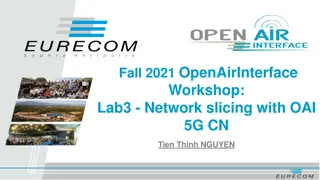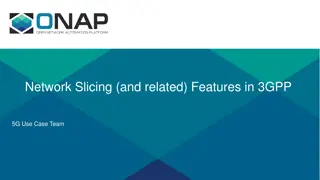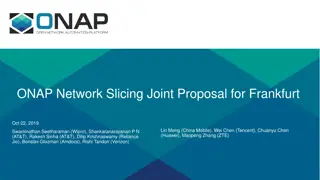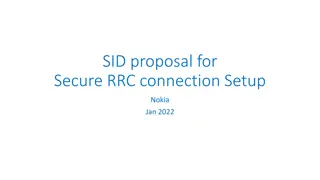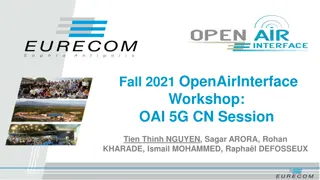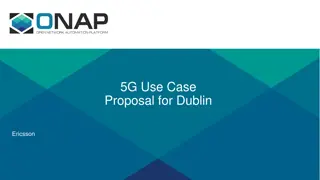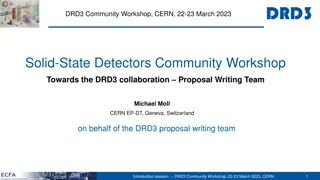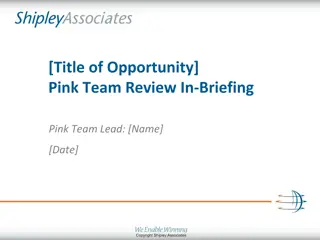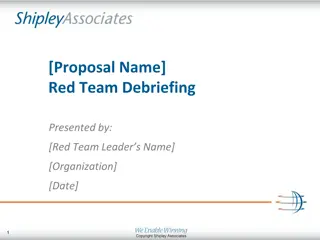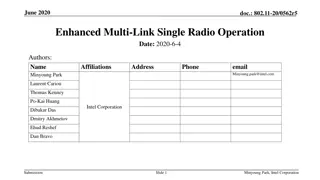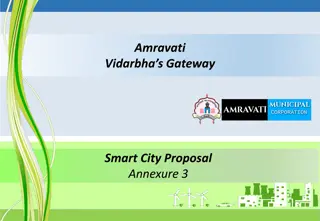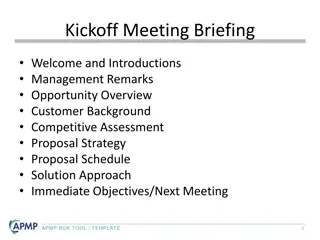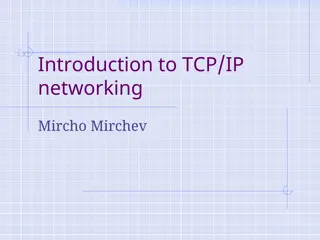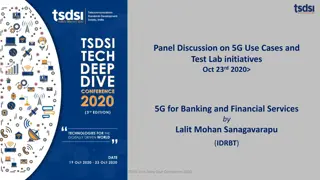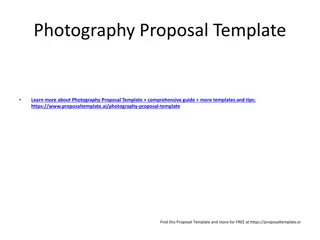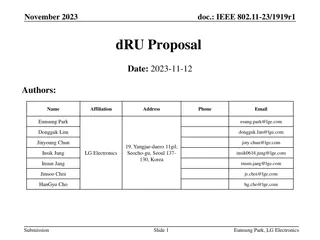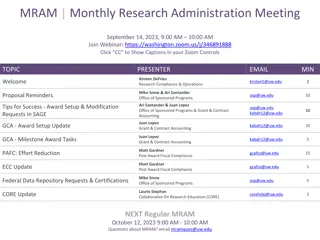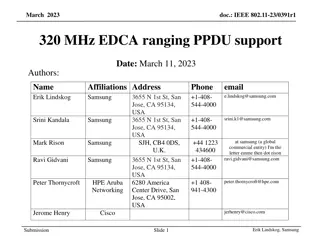R7 Network Slicing Model Proposal and Structure Overview
Explore the modeling requirements for R7 network slicing, focusing on slice subnet domain combinations within the NST model. The proposal delves into CST, NSST, slice profiles, NF configuration, and more to enhance the understanding of network slicing. Learn about the modeling structure, CST-DT relations, and the role of RAN capabilities in the overall framework. Dive into the intricacies of NST modeling structures and the flow of services in the R7 ecosystem.
Download Presentation

Please find below an Image/Link to download the presentation.
The content on the website is provided AS IS for your information and personal use only. It may not be sold, licensed, or shared on other websites without obtaining consent from the author. Download presentation by click this link. If you encounter any issues during the download, it is possible that the publisher has removed the file from their server.
E N D
Presentation Transcript
R7 E2E Network Slicing Model Proposal
Modeling Requirements for R7 3 Slice subnet domain combination in NST Model RAN TN slice subnet, go further in modeling CN at NF level - Includes:1) NSST 2) slice profile 3) NF configuration Add slice profile templates Update CST NST NSST profile attributes KPI monitoring(Currently, consider a separated design, will not include in the design of P3) Update AAI instance model NSSI capabilities status- may be tracked in AAI or CPS? Seems only needed in RAN/TN or RAN itself? Has any impact in NSST or NST design? Or only needed in runtime
R7 Modeling Structure CSMF NST: ONAP concept, Nework Slice(NS) max capability and composited by Network Slice Subnet(NSS) capability (operator provides) NSST: ONAP concept, NSS max capability (operator provides) ONAP CST 1 CFCS Nested Service Profile(T): specific NS requirement Slice Profile (T): specific NSS requirement 1 RFCS Allotted resource NST and ServiceProfile(T): In DT, NST defines one NS max capability (eg. maxNumberofUEs:10000) which is based on operator network capability. While ServiceProfile(T) defines concrete NS which is from service requirement (eg. maxNumberofUEs:3000) In RT, OOF shall based on policy/rules to select related NST for NS requirement first. Service Profile T (Service Profile) NSMF NSI Service Profile NST Nested 1 Allotted resource 1 * NSSMF 0..* NSSI Slice Profile AllottedResource: indicate one NS/NSS requirement in DT need find a NSI/NSSI to carry in RT Allotted resource Slice Profile T NSST There will be RAN NSST, CN NSST and TN NSST, and slice profile templates for 3 subnets separately. * * Managed Function Enhancement in R7 3gpp concept mapping in RT, not DT
R7 Model Flow CST DT relation 2 Allotted resource here is to show one NS requirement need find a NSI to carry. 1 RT relation AllottedReso urce ServiceProfile (T) 3 NST Here NST associate AllottedResou rce in DT, where AllottedResou rce contains NSST ID in DT. OOF use policy/rules to do NST selection first in RT. Slice Profile(T) Slice Profile(T) 4 Allotted resource here is to show NSI need NSSI to compose, NSSI can be new or a existed one. AllottedReso urce AllottedReso urce AllottedReso urce AllottedReso urce 5 Allotted resource here is to tell each slice profile requirement should find an NSSI to carry. Just need create an relationship, don t need to do any selection. NSSI selection needs slice profile as assistance NSST NSST Intel Confidential
R7 Modeling Structure - update Does FH and MH are decided by RAN? How to model RAN capabilities? CST 1 1 Nested Allotted resource Service Profile T (Service Profile) 1 Nested NST * Slice Profile T Allotted resource NSST RAN Slice Profile T CN Slice Profile T TN Slice Profile T TN NSST/TN Service Model RAN NSST/RAN Service Model CN NSST Allotted resource Allotted resource Allotted resource BH TN NSST FH TN NSST MH TN NSST
CN NSST CN NSST Nested <Includes> * Weconsider only1 in G release Nested 1 Basic Slice Capabilities Informations SD/NSD SD/NSD * * Latency, uEMobility Level, expDataRat eDL, etc. Nsst ID, sst,etc. (AMFaaS, UPFaaS, ) * VNFD Can Implement AMF UPF Intel Confidential
Details about CN model 1 NSST can be used to instantiate multiple NSSI with same capabilities defined in NSST, NSD can decide NSST capabilities. CN NSST CN NSSI When NSSI is shared, there can be multiple. * * 1..* 1 1..* Network service Instance NSD In general, 1 NSST only includes 1 NSD , in some situation, 1NSST can include multiple NSDs 1 NSD will include all the description of needed network functions(AMF,UPF...), and the numbers of them. Intel Confidential
Next step to enable Internal NSSMF Model design NSD design options :1)Onboarding NSD with certain functions , 2)onbording VNFD with certain functions, and design NSD/SD in SDC (Current SDC status for NSD support: currently reusing AID SD to carry NSD information, the new development for supporting ETSI NSD design is ongoing target finish in G release.) After finishing NSD design( with template published), NSST will create association with the NSD. NSD should include: 1) AMF(VNFD), UPF(VNFD), etc. and VLD to tell topology and functionalities 2) Endpoint mapping from NSSI to MF level (NSD can use CP to describe). SO Need detailed workflow about NSSMF in SO, between NSSI layer and NSD layer may use ONAP SO APIs. AAI Current model design has include Network service instance relationship, AAI has support Network service instance object , need reuse Service instance now, after supporting ETSI alignment in Guilin release, we can consider Network service instance. Need recognize the impact on NSSI selection and etc. Intel Confidential
RAN NSST/ RAN Service Model Option 1 <Refers> RAN NSST/RAN Service Model <Includes> 1 1..* 0..* 0..* Basic VNFD/ PNFD Capabilities VLD Informations TN NSST NSD/VF Is classified to Nsst ID, sst,etc. MaxNumberofUEs, uEMobilityLevel, etc. Pre-defined planned values. CU DU RU CU DU RU Option 1: One RAN network, using alloted- resource to tell instantiate RAN NSSI must find a RAN network. Then don t need capabilities Option2: Different RAN topologies provide capabilities, thus has corresponding NSSTs. List of Vnfcs know how many CU DU are. Physical PNF onbo Intel Confidential
RAN NSST/ RAN Service Model Option 2 RAN NSST/RAN Service Model <Includes> 1 1..* 0..* Basic VNFD/ PNFD Capabilities VLD Informations NSD/VF Is classified to Nsst ID, sst,etc. MaxNumberofUEs, uEMobilityLevel, etc. Pre-defined planned values. CU DU RU CU DU RU Intel Confidential
RAN Service Model NRT RIC E2 E2 Optional VL VL NG-c EP F1C FH CUCP RU DU VL VL E2 VL F1U E1 VL VL NG-u EP CUUP
RAN Service Model TS 28.541 - V16.5.0 (2020-06) - 4.2 3-split NG-RAN deployment scenario, represents the gNB consist of gNB-CU-CP, gNB-CU-UP and gNB-DU
RAN Service Model DU Data Type Properties DU service holds a list of DUType: DUList as well as DU resource (that may be vendor specific) DUType - Data type based on TS 28.541 - V16.5.0 (2020-06) - 4.3 GNBDUFunction and NRCellDU NRCellDU Attribute name cellLocalId operationalState administrativeState cellState pLMNInfoList nRPCI nRTAC arfcnDL arfcnUL arfcnSUL bSChannelBwDL ssbFrequency ssbPeriodicity ssbSubCarrierSpacing ssbOffset ssbDuration bSChannelBwUL bSChannelBwSUL GNBDUFunction Attribute name gNBDUId gNBDUName gNBId gNBIdLength rimRSReportConf NRCellCU.pLMNInf oList It defines which PLMNs that can be served by the NR cell,and which S-NSSAIs can be supported by the NR cell for corresponding PLMN in case of network slicing feature is supported allowedValues: Not applicable. NRCellDU.pLMNIn foList It defines which PLMNs that can be served by the NR cell, and which S-NSSAs can be supported by the NR cell for corresponding PLMN in case of network slicing feature is supported. The pLMNId of the first entry of the list is the PLMNId used to construct the nCGI for the NR cell. Attribute related to role nRSectorCarrierRef bWPRef nRFrequencyRef victimSetRef aggressorSetRef allowedValues: Not applicable.
RAN Service Model CUUP Data Type Properties CU-UP service holds a list of CUUPType: CUUPList as well as CUUP resource (that may be vendor specific, e.g. deployment artifacts) CUUPType - Data type based on TS 28.541 - V16.5.0 (2020-06) - 4.3 GNBCUUPFunction Attribute name gNBCUUPId pLMNInfoList gNBId gNBIdLength Attribute related to role configurable5QISetRef
RAN Service Model CUCP Data Type Properties CU-CP service holds a list of CUCPType: CUCPList as well as CUCP resource (that may be vendor specific, e.g. deployment artifacts) CUCPType - Data type based on TS 28.541 - V16.5.0 (2020-06) - 4.3 GNBCUCPFunction NRCellCU MappingSetIDBackhaulAddress BackhaulAddress Attribute name Attribute name Attribute name gNBId gNBIdLength gNBCUName pLMNId x2BlackList x2WhiteList xnBlackList xnWhiteList x2XnHOBlackList mappingSetIDBackhaulAddressList Attribute related to role configurable5QISetRef Attribute name cellLocalId pLMNInfoList setID backhaulAddress gNBId tAI Attribute related to role nRFrequencyRef nRTAC TAI This holds the identity of the common Tracking Area Code for the PLMNs. Attribute name allowedValues: a) b) c) d) pLMNId nRTAC It is the TAC or Extended-TAC. A cell can only broadcast one TAC or Extended-TAC TAC is defined in TS 23.003 and Extended-TAC is defined in TS 38.473 For a 5G SA (Stand Alone), it has a non-null value
AAI Model for Network Slicing in R7 - RAN Nrt RIC Instance Properties 1 1 NSSI Nrt RIC 1 1 1 1 1 1 E2 * DU 1 DUType * DU 1 * Instance Properties E2 E2 * F1 C 1 F1 U * CUCPType CUCP Instance Properties 1 * * CUCP 1 E1 New Added CUUPType CUUP Instance Properties 1 * * * 1 * CUUP Existed Intel Confidential
AAI RAN Instance Model UML Intel Confidential
Option 1 RAN NSST Structure NST CN NSST RAN NSST BH TN NSST RAN NF (For CU DU) FH TN NSST MH TN NSST Intel Confidential
TN NSST TN NSST/TN Service Model <Includes> Basic Capabilities Informations Alloted resource Nsst ID, sst,etc. latency, jitter, reliability Network A logic link between RAN and CORE Link CCVPN Intel Confidential
Network View Option 1 NSI (NSMF) TN - BH NSSI Core NSSI RAN NSSI (NSSMF) TN-MH NSSSI RAN NFs NSSSI TN-FH NSSSI RU1 (PNF) RUn (PNF) DU1 (VNF) CU (VNF) AMF SMF UPF MH FH BH Network Service DUm (VNF) FH RAN Network Service For Guilin, RU will be PNF, and DU/CU will be VNF. Will have NSST, and 1 or more Slice Profiles associated to it.
Network View Option 2 NSI TN - BH NSSI Core NSSI TN-MH NSSI RAN NFs NSSI TN-FH NSSI RU1 (PNF) RUn (PNF) DU1 (VNF) CU (VNF) MH FH AMF SMF UPF DUm (VNF) BH Network Service FH RAN Network Service For Guilin, RU will be PNF, and DU/CU will be VNF. Will have NSST, and 1 or more Slice Profiles associated to it.
s Thank You!



